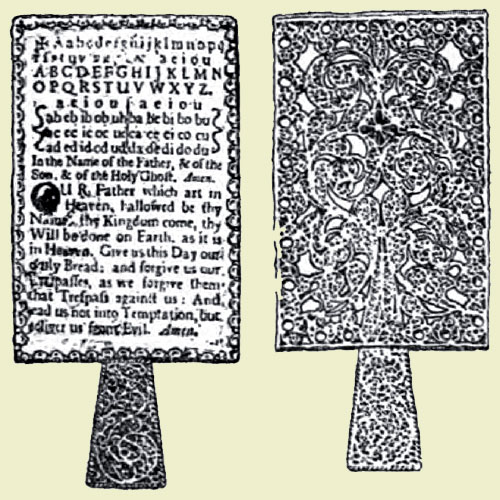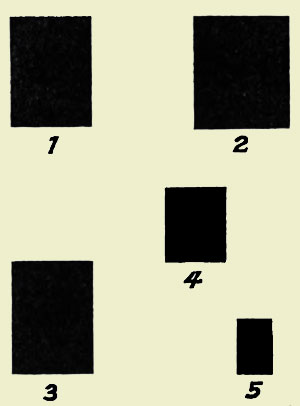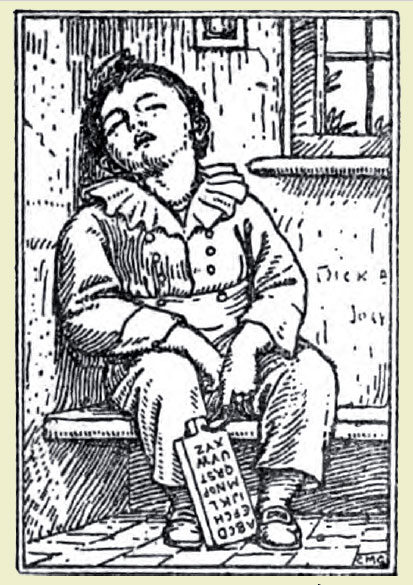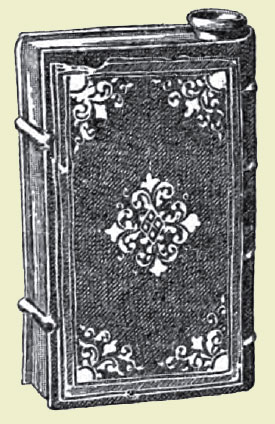The World’s Most Curious Books
The Bookman, March 1921
| Archives of out-of-copyright material in the creative commons provides Blackbird a chance to rediscover and recommend texts and images from a world of pre-digital publishing. . . . (more) | ||
Blindfold a confirmed librarian or bookworm and he will tell you a surprising deal about a book merely by the heft and feel of it. Not just a matter of weight or bulk or texture—the arcana of the initiated plumb deeper. The master book-knower—a Putnam, Winsor, or Paltsits, a Garnett, Pollard, or Gosse—can almost appraise a tome in the dark and tell you it is of low degree and doubtless dross, or caress an élite duodecimo and call it more than treasure. Indeed he will frequently be able to tell the approximate decade of its publication by touch, smell, the crackle of its leaves, and characteristics of its very edges. This talent is as esoteric as Hindu levitation and certainly more dependable than professional weather forecasting!
Aside from a person’s apparel, his face, figure, bearing, gait, and other outward tokens reveal much of the man within. To the keen observer the hands alone are often a confession or a credential. So the chronic reader comes to know and judge books by a sort of trained intuition before he has glanced at the title-page. The outward signs of a ribbed back or a silk head-band bespeak quality as readily as do immaculate and tapering fingers.
 |
| A Horn-book or Abecedarium |
Somewhere there is a tawny volume bound in Bengal tiger, with a white feline fang protruding from each corner. It came from a noted French collection of fantastic bindings dispersed at auction in 1874. There were books in this library in the skins of crocodile, mole, seal, civit, lizard, and rattlesnake. There were volumes bound in a Canadian black wolf, otter, and white bear. There were specimens in feather work, and in tortoise shell inlaid with mother of pearl and silver. Strangest of all was an angling book bound in the shellacked scaly mail of a sole.
General Sir George Napier had a work clothed in a piece of Charles the First’s silk waistcoat. It was a life of the celebrated dwarf, Jeffery Hudson, who measured 18 inches, fought a duel with a turkey-cock, and at royal banquet was brought to table in a make-believe pie.
More than once have books been bound in human skin. A Russian poet is said to have presented to the lady of his affections a collection of his sonnets bound in his own integument. The astronomer Flammarion having admired the exquisite skin of a beautiful lady of title whom he met at a reception, she bequeathed it to him. When she died, he received a square of tissue and, in accordance with instructions accompanying the legacy, had a copy of his own work Ciel et Terre bound therein.
There is one erratic book collector whose every accession is uniformly rebound in red morocco before being put on his shelves. This was once commonly done by the nobility, whose armorial bearings were emblazoned on their books as on their coaches. Each of the three daughters of Louis the Fifteenth had her own library. Madame Adelaide had all her books bound in maroon morocco. Madame Sophie’s were in citron; Madam Victoire preferred Nile green.
An extraordinary volume which long belonged to the family of the Prince of Ligne is by some esteemed the most curious book in the world because it is neither written nor printed. The letters of the text are cut out line by line and page by page with the vellum folio. Being interleaved with tinted paper, it is easily read.
The above volume is perhaps outdone in strangeness by a Wordless Book wich except for the title-page contains not one syllable. It was devised by a person of strong religious bent who thought to convey an allegory in the color scheme of its leaves, of which two are black, two crimson, two white, and two gold. The black symbolizes the unregenerate heart of man; the crimson, the divine redemption; the white, the purity of the soul “washed in the blood of the Lamb”; the gold, the felicity of eternal beatitude.
Wilkes’s Essay on Woman, 1772, is printed throughout in red ink. The Book of Four Colours, by one Caracicoli, was issued at Paris in 1757 in gamboge, ultramarine, sepia, and vermillion inks. To test the legibility of colored paper and ink, the mathematical tables devised by Babbage were printed in twenty–one volumes at London in 1881. Only one copy of this truly unique work was made. One hundred and fifty–one tints of paper were used and ten hues of ink. The last volume contains metallic printing in gold, silver, and bronzes, on vellum and colored papers.
A temperamental author, Monsieur de Rochas, contended that paper and ink as well as type should be in harmony with the printed word. Thus a love poem should appear in pale ink on rose-colored paper, to convey the delicacy of its impress on the reader.
When Queen Elizabeth was a plump princess, the vogue of embroidered book covers was in its heyday. Princess Elizabeth was adept in this as in other handiwork. She plied her needle with a fine artistry. Two specimens of her book embroidery are treasured in the British Museum.
The custom of chaining books was once common throughout Europe. When there was a row of such books, each chain was fastened to a book by a staple and had a ring at the other end which permitted it to slid on a rod beneath the shelf and to be lifted to an adjacent lectern. The arrangement was like the rings on a curtain pole. The volumes were usually bulky and the attached chains about a yard long. The precaution prevented theft but not mutilation.
 |
| Chained Books, Hereford Cathedral, England |
In those days books were not for the populace, but were precious possessions of the church and nobility. Even with the spread of the enlightenment and printing, most of these chained libraries and isolated tomes remained in duress. It required a smith to release them, as it had to put them in gyves. At Oxford University the library was fettered for three centuries, and the dons were prone willfully to tangle the chains. To this day shackled books are met with here and there abroad. The array in Hereford Cathedral, England, is doubtless the most extensive, numbering fifteen hundred volumes. Even the library catalogue is riveted to its stand. Occasional accessions are chained as of yore.
The extra-illustration of books by the insertion of prints pertaining to the text was a craze comparable only with tulipomania in Holland when fabulous sums were spent for rare bulbs. James Granger, whose hobby was print collecting, in 1769 published A Biographical History of England in which blank leaves were interspersed for filling in additional illustrations. This gave rise to “grangerizing”, or searching for portraits of celebrities mentioned in the text and of scenes described and inserting these in the volume.
It is not generally known that the Chinese invented the encyclopædia. In 1408 the colossal Yung-Lo-Ta-Tien, or Great Encyclopedia of Yung-Lo, was completed. At the command of this emperor, three commissioners, with five directors, twenty supervisors, and a staff of 2,141 assistants, labored for five years compiling it. In magnitude it was the greatest literary undertaking the world has known. It contained 917,480 pages and 366,992,000 characters.
Of the books which are remarkable for oddity by reason for their contents rather than their appearance, that written by Timothy Dexter outdoes most. This screed, A Pickle for the Knowing Ones, or Plain Truths in a Homespun Dress, is without an iota of punctuation, though capitals are sprinkled with a fine frenzy. A second edition of this masterpiece has a page consisting of line after line of commas, semicolons, colons, and interrogation points for the convenience of those finicky readers who wish to “peper and solt” the text to their liking. The author confides that he speaks with “the voise of the peopel and cant Help it."
 |
Smallest Books in the World 1. Bijou Almanack 3/4 x 1/2) |
Small books have always been much sought. Monsieur Salomon of Paris was the most noted collector who has specialized in these specimens of the Lilliputian press. He acquired more than two hundred.
One famous small book is The English Bijou Almanack for 1837, issued as a souvenir of Queen Victoria’s assession to the throne. It is three–quarters of an inch tall, one–half inch wide, and one–eighth inch thick. It has thirty–seven pages.
The Bijou Almanack is engraved, however, and not printed from type. It is therefore eclipsed by that other diminutive volume The Mite, which is one–eighth inch wider. The Mite was for a time deemed the smallest book ever printed from movable type. The difficulty of making and handling a font of type such as this may be judged when it is said that four thousand i’s weigh one pound. The little known Alarm Almanac, which appeared at Paris in 1781, is also from type and measures about three–quarters by nine–sixteenths of an inch, being one–sixteenth narrower than The Mite.
Monsieur Salomon thought he had the smallest book in the world. It was a Dutch work printed in 1674, containing forty–nine pages, one–fourth the size of a postage stamp, and called Bloem Hofje door, or The Court of Flowers.
But he erred, for there is a tome of 208 pages, each page with nine lines and about one hundred letters, which is 9 1/2 millimetres by 6 (25.4 millimetres making an inch). This book of slightly over one-third of an inch by a shade less than one-fourth, was printed by Salmin in 1897, and contains a hitherto unpublished letter of Galileo to Madame Cristine of Lorraine. The text is Italian.
Savants know of several Greek compositions in which one letter of the alphabet is omitted throughout. There is a small Latin prose work by Fulgentius with as many chapters as there are letters in the alphabet. The first chapter is without an a; the second without b; and so on. There are five Spanish stories by Lope de Vega, each omitting one vowel. Then there is a mediæval Latin tract by one Hugbald in which every word begins with a c. Were these collected in one volume, it would assuredly make one of the most curious of books.
One private collector of Bibles has more than 2,000 in various editions and tongues. In the British Museum are upwards of 16,000 copies of the Scriptures or parts thereof. These represent over 2,700 editions in eighty-three languages. There were fifty-seven distinct American Indian idioms north of Mexico; but Eliot's Bible in the Massachuset tongue was for two centuries the only native translation. It was the first Bible printed in America.
 |
| A fig for learning! |
Did you ever possess an abecedarium? This Latin-sounding term merely denotes an A-B-C- primer. Before the boon of schoolbooks, children learned the alphabet from horn-books. These are not books in the ordinary sense, any more than the terracotta tablets of the ancient Assyrians. The abecedaria known as horn-books resembled milady’s hand-mirror except that the handle was usually perforated so that it could be strung to the youngster's girdle. Most horn-books bore the alphabet, numerals, and the Lord’s Prayer on a card which slid into grooves or was tacked to the blade. This was covered with a sheet of transparent horn, like mica. Horn-books were usually of wood or bone; but ivory or silver filigree specimens were used among the gentry. Even these, however, fade in charm beside the ginger-bread horn-books of which it was written:
And that the child may learn the better,
As he can name, he eats each letter.
 |
| A Bottle Book |
It remains only to mention bottle-books which are as rare as fish that climb trees. These curiosities were made in southern France about a century ago and were held in great esteem by judges, advocates, and the learned gentry generally. The legal profession was given to carrying its authorities back and forth under its austere arm. Hence these reliures-bouteille which were made of lustrous decorated dark blue faience, in appearance not unlike tooled levant. The contents were wholly liquid or partly literary with a fortifying compartment. Then the bibulous bibliophile took a nip for his constitution. Now the Constitution nips the bibulous bibliophile. ![]()
Walter Hart Bloomenthal was born in Clinton, Iowa in 1883. Around the time “The World's Most Curious Books” appeared in The Bookman, Blumenthal was listed by the American Jewish Yearbook as an editor and poet living in New York City. Over the course of his career, Blumental wrote books about books and “literary oddities” as well as books and essays on historical and literary topics. Select titles include Bookmen's Bedlam (Rutgers University Press, 1955), Filgaree Lettering and Ornamentation (W.H. Blumenthal, 1957), Bookmen's Trio: Ventures in Literary Philandering (A.J. St. Onge, 1961), and Imaginary Books and Phantom Libraries (G.S. MacManus, 1966).
Introduction
The World's Most Curious Books
Notes and Acknowledgements